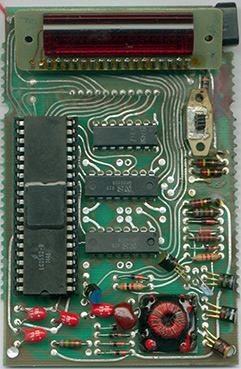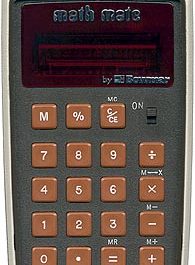
The Bowmar MX55 is a handheld calculator from 1974. It measures 3.1 inches wide, 5.9 inches high, and 1.4 inches deep. The MX55 weighs 126 grams without the battery. It is powered by internal rechargeable batteries that provide about 5 hours of use per charge. A two-pin AC adapter can be plugged into the right side to recharge the batteries.
The MX55 has a two-piece plastic case construction. One piece is matte black while the other is glossy black plastic. It has a sculpted design with smooth edges. The keyboard area and display are framed by a silver painted edge. The keys make an audible click when pressed. At the top, the Bowmar name is printed in black, red and silver. The eight-digit display uses flat red LEDs, which provide a wider viewing angle compared to more common bubble LEDs of the time. An extra digit indicates negatives, overflow and low battery.

Inside the calculator, the main circuit board sits on top of the keyboard assembly. Various integrated circuits, transistors, diodes, capacitors and resistors make up the electronics. The Bowmar MX55 performs the four basic arithmetic functions and percentages. It exhibits some logic flaws common in early handheld calculators, including the negative zero bug and fixed decimal point issues. Overflow and divide by zero errors are indicated and recoverable.

The MX55 was manufactured by Bowmar/ALI in Acton, Massachusetts and assembled in Mexico. Despite its limitations, the calculator’s display and case design were quite good for the era. As an early pocket calculator, the Bowmar MX55 is an interesting example of the technology in transition.
